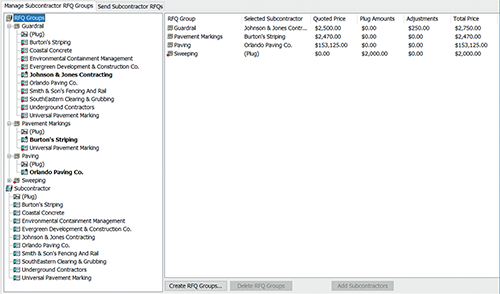
An essential step
Bidding for heavy construction jobs gets more complex for general contractors when portions of the work and required materials must be, or could be, performed or provided by other companies.
Fortunately, specialized software for estimating provides substantial advantages in the profit-critical estimating process of analyzing and choosing the most appropriate subcontractors and vendors or deciding whether or not to self-perform. These advantages can’t be duplicated with spreadsheets or paper-based methods. They enable general contractors to complete estimates faster and to bid more aggressively, with more confidence in their numbers.
 Leading estimating software applications send consistent RFQs (requests for quotation) to subcontractors and vendors. Automation and a consistent, centralized process then assists estimators in analyzing the submitted quotes and selecting the lowest or most appropriate bidder or in splitting work among multiple subcontractors and vendors to get the best possible overall price. The software can also help them evaluate multiple scenarios and options quickly and efficiently in the bidding process.
Leading estimating software applications send consistent RFQs (requests for quotation) to subcontractors and vendors. Automation and a consistent, centralized process then assists estimators in analyzing the submitted quotes and selecting the lowest or most appropriate bidder or in splitting work among multiple subcontractors and vendors to get the best possible overall price. The software can also help them evaluate multiple scenarios and options quickly and efficiently in the bidding process.
These essential comparison and analysis operations could be done manually or within spreadsheets, but that takes a lot of time, and the potential for error is significant. As a result, contractors not utilizing specialized software often take short cuts or forgo thorough vendor and subcontractor analysis altogether to meet bid submission deadlines. They run the risk of bidding too high to play it safe or bidding too low and losing money.
Establishing a pre-populated database of cost items, including materials, and templates for work a contractor self performs is a fundamental concept of specialized software for estimating that makes building bids a faster and more accurate process. Similarly, with a good estimating software application, contractors can pre-populate the system with information on subcontractors and vendors. This can range from basic contact information and capabilities to detailed data on quality, qualifications, historical performance, pricing and more.
With potential subcontractors and vendors already in the system in advance, contractors can request, enter and evaluate bids from them in a centralized and cohesive manner. Everything is in one place, making an apples-to-apples comparison easy and improving opportunities to select the most effective and profitable options.
Step one is to create RFQ groups identifying tasks and materials for which the general contractor will seek bids from subcontractors and vendors. The software system will then match those items with potential providers in the database. Estimators can then select one or more providers and send consistent RFQs to all of them directly from the software. They can add general notes about the requirements to all of the RFQs or include notes specific to each individual one.
The estimating software and its database of subcontractors and vendors should allow general contractors to easily identify unique qualifications or circumstances impacting the selection and factor these into the comparison. These could include things like whether a company is minority-owned or woman-owned.
When bids are received, the estimating software can arrange them in a grid for a side-by-side comparison and analysis. Many general contractors will also establish their own estimated or ‘plug’ numbers for the subcontracted work or materials when they begin to build their base bid and include these for purposes of comparison. Better software programs allow estimators to compare an unlimited number of bids and sort them within the grid according to multiple variables.
Another key software feature is the ability to easily amend figures provided by each subcontractor or vendor to make quote comparison and analysis more accurate. A general contractor, for example, might anticipate from past jobs how much oversight a specific subcontractor will require, how likely it is that the company will meet deadlines or how much rework might be required. The quote from that company could then be increased or decreased accordingly by a specified amount or percentage.
On many projects and for many general contractors, deciding which portions of the job to perform and which materials to provide themselves has a critical impact on profit potential. Some weigh these options all the time and for dozens of items in a bid based on their resource allocation, plant capacity, equipment availability, the location of the job or other factors that impact their costs versus those of a third party.
Estimating software provides a huge advantage in this scenario, allowing general contractors to essentially include themselves and their own numbers in the comparison of potential subcontractors and vendors. Seeing all of the options side by side makes it easier to make the most profitable decision for each individual item or material.
Once the comparisons are complete and the most effective subcontractor, vendor or self-performance options are selected, estimating software can pull these figures into the base bid with the push of a button. This eliminates a final opportunity for error or miscalculation through redundant, manual data entry.
Stakes are high in a heavy construction bid. For general contractors, effective analysis of the subcontractor and vendor components can often be the difference between winning and losing a job or between making or losing money on it. With so much opportunity and risk in the balance, choosing specialized estimating software over spreadsheets is an essential step for consistently choosing the right companies to work with on each project.
Greg Norris is director of marketing communications for B2W Software. The company’s ONE Platform connects people, workflows and data and includes advanced, unified applications to manage estimating, scheduling, field tracking, equipment maintenance, data capture and business intelligence.
https://www.b2wsoftware.com/products/construction-safety-software/
Greg can be reached at gnorris@b2wsoftware.com